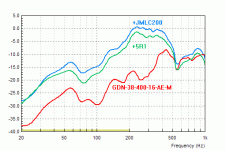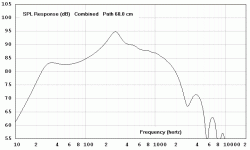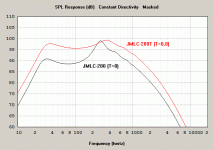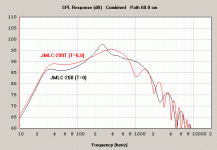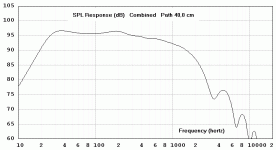Hello,
Romy is totally wrong on that.
( a parte: I hypothesize that Romy's sentence: "why I don't not like Le Cléac'h (La) horns " doesn't find it's origin in any theorical nor technical consideration... please note that one of Romy's reproach against me is that, in his not humble opinion, I don't share enough my own philosophical considerations about what a good sound should be nor I share enough my own ideas about the proper setting up of a complete audio system... )
At high frequency, the waves takes off from the wall of the horn at a shorter distance from the throat than for the lower frequencies, therefore, at HF the roll-back mouth has no effect.
At low frequency, the wavefronts leaves the wall of the horn at a large distance from the throat. with an unbaffled tractrix horn this means that the low frequency waves will be partly reflected at the edge of the mouth.
Give a look to:
http://www.diyaudio.com/forums/atta...30125-jean-michel-lecleach-horns-rollback.png
You can see the effect of the reflected waves on the half upper part of the polar graph corresponding to a truncated Le Cléac'h horn.
Then, you can see in the lower half of the graph the increased smoothness of the polar graph of the "complete roll-back" Le Cléac'h horn .
Then there is the problem of the integration with the bass channel and with the highs. I don't think that the eventual integration problems associated with the increased diameter of the Le Cleac'h horn are of the same importance level than the benefits of the reduction of the reflected and diffracted waves at the mouth.
Best regards from Paris, France
Jean-Michel Le Cléac'h
Romy is totally wrong on that.
( a parte: I hypothesize that Romy's sentence: "why I don't not like Le Cléac'h (La) horns " doesn't find it's origin in any theorical nor technical consideration... please note that one of Romy's reproach against me is that, in his not humble opinion, I don't share enough my own philosophical considerations about what a good sound should be nor I share enough my own ideas about the proper setting up of a complete audio system... )
At high frequency, the waves takes off from the wall of the horn at a shorter distance from the throat than for the lower frequencies, therefore, at HF the roll-back mouth has no effect.
At low frequency, the wavefronts leaves the wall of the horn at a large distance from the throat. with an unbaffled tractrix horn this means that the low frequency waves will be partly reflected at the edge of the mouth.
Give a look to:
http://www.diyaudio.com/forums/atta...30125-jean-michel-lecleach-horns-rollback.png
You can see the effect of the reflected waves on the half upper part of the polar graph corresponding to a truncated Le Cléac'h horn.
Then, you can see in the lower half of the graph the increased smoothness of the polar graph of the "complete roll-back" Le Cléac'h horn .
Then there is the problem of the integration with the bass channel and with the highs. I don't think that the eventual integration problems associated with the increased diameter of the Le Cleac'h horn are of the same importance level than the benefits of the reduction of the reflected and diffracted waves at the mouth.
Best regards from Paris, France
Jean-Michel Le Cléac'h
Lars ... thanks. I didn't have the 2007 spreadsheet to do throat angles when I wrote that. I'm feeling much better now.
While I'm here good old Romy mentioned that he thought the Le Cleac'h roll was less effective at low frequencies: GoodSoundClub - Romy the Cat's Audio Site - Why I do not like La-horns. The tomatoes? If so sure cuts the diameter down a bunch. 30" plus does get cumbersome if trying to turn. Any one have more ideas on this?
Zene
Lars ... a picture (thanks for running) is worth many Romy words; sometimes incoherent, sometimes great. And, he could be referring to upper bass.
I will get into HornResp more and do my own evaluations.
Is there a particular set of driver values for 1" and 2" throats that are better than others for speaker input data?
I will be using my JBL 2420's (no Ti's for me, yet) for all 1" horns and two Atlas 1" drivers into a 2" JBL adapter for all lower frequency horns.
Zene
I will get into HornResp more and do my own evaluations.
Is there a particular set of driver values for 1" and 2" throats that are better than others for speaker input data?
I will be using my JBL 2420's (no Ti's for me, yet) for all 1" horns and two Atlas 1" drivers into a 2" JBL adapter for all lower frequency horns.
Zene
Jmmlc ... "Hello,Romy is totally wrong on that." As you know I put his post here for a good reason. Thanks for reply.
So my answer, indirectly, is to build as big a lower frequency horn as I'm capable of doing, keeping your roll-back in tact and create Bass/UB conventional speaker(s) to get there. With luck my Jensen UltraFlex with a JBL D130 will do just that. I think 300 Fc will do nicely.
Zene
So my answer, indirectly, is to build as big a lower frequency horn as I'm capable of doing, keeping your roll-back in tact and create Bass/UB conventional speaker(s) to get there. With luck my Jensen UltraFlex with a JBL D130 will do just that. I think 300 Fc will do nicely.
Zene
Now is the elephant in the room: “I don't think that the eventual integration problems associated with the increased diameter of the Le Cleac'h horn are of the same importance level than the benefits of the reduction of the reflected and diffracted waves at the mouth.” The integration problems associated with the increased diameter is a HUGE problem, really HUGE and if Mr. Le Cléac'h do not spend time to collect graphs, build theories but play with practically of playback then he would not deny it. The reduction of the reflected and diffracted waves at the mouth is good but in my estimation it is way less important, not to mention that it work ONLY at HF. I personally feel that randomizing mouth edge is way more effective then negative opening and it takes no extra toll of the size of individual channel.
That is a really funny one......
Mr. " i know it always better " strains out a gnat, but swallows a camel!! he cares about some more inches of increased diameter at lower midrange and midrange channel, as being a HUGE integration problem, but places his midbass horn on the roof, meters away, completely disassociated from from the main horn channels, and feels perfectly fine with that. 🙄
Jmmlc or anyone familiar ... how do I print out full size graphic drawings? By hand is not what I prefer and AutoCad isn't an option, way too expensive to have someone do. The Office Depot types do not even print on graph paper any more.
angeloitacare ... I find his (Romy) thinking is like crawling around the box, not thinking outside or inside, but there are a few twinges of sage advice in some of his mistyped rantings. Does seem weird to time align to the thousands of an inch on some and puts the MB next door.
Thanks, Zene
angeloitacare ... I find his (Romy) thinking is like crawling around the box, not thinking outside or inside, but there are a few twinges of sage advice in some of his mistyped rantings. Does seem weird to time align to the thousands of an inch on some and puts the MB next door.
Thanks, Zene
Print on VERY large paper. reminds me of the old gerber plotter bigger than a king size bed we used to use 20 years ago.
Hi Zene,
Your lowmid ideas are interesting!
Checked the 60W Atlas and it could work albeit in a fairly narrow range. Jean-Michel showed something quite similar many posts back.
Should be OK if you mated the 2420 with a 7-800Hz LeCleach. Lower Fc should maybe be 3-400Hz.
Why an adapter? Couldn´t you build the horns for 1" instead. But 2" could be idea if you later want to change driver.
Your lowmid ideas are interesting!
Checked the 60W Atlas and it could work albeit in a fairly narrow range. Jean-Michel showed something quite similar many posts back.
Should be OK if you mated the 2420 with a 7-800Hz LeCleach. Lower Fc should maybe be 3-400Hz.
Why an adapter? Couldn´t you build the horns for 1" instead. But 2" could be idea if you later want to change driver.
Lars ... I'd better be more specific so is no miscommunication.
Lower mid horn, Fc 200hz 2" throat to use two of these Atlas drivers Atlas Sound - PD-5VH per horn with the JBL two into one adapter. I hope I can get down pretty low but will take what I can get. I don't model.
The mid will be some form of Jmmlc's horn design also, 2" throat and use a P.audio 1" to 2" adapter even though is not ideal, will make mounting and experimenting a lot easier. Driver is JBL 2420 as I mentioned. Super tweeter if needed.
Zene
Lower mid horn, Fc 200hz 2" throat to use two of these Atlas drivers Atlas Sound - PD-5VH per horn with the JBL two into one adapter. I hope I can get down pretty low but will take what I can get. I don't model.
The mid will be some form of Jmmlc's horn design also, 2" throat and use a P.audio 1" to 2" adapter even though is not ideal, will make mounting and experimenting a lot easier. Driver is JBL 2420 as I mentioned. Super tweeter if needed.
Zene
First of all go for a single driver as this will probaly better performance. Then go for one PD60A as it has a much flatter response. Also about an adapter it will probably not have a LC flare. It´s more realistic to expect to use it from 3-400Hz up to maybe 1,5-2kHz.
Check post 95 it might be the same driver.
http://www.diyaudio.com/forums/multi-way/140190-jean-michel-lecleach-horns-10.html#post1781991
About the high mid, also go for a 1" throat for the same reason as above. Why not check the Auto-Tech check groupbuy.
http://www.autotech.pl/pdf/audio_en.pdf
Hope this isn´t a problem to show, but we have very good experience from these.
Check post 95 it might be the same driver.
http://www.diyaudio.com/forums/multi-way/140190-jean-michel-lecleach-horns-10.html#post1781991
About the high mid, also go for a 1" throat for the same reason as above. Why not check the Auto-Tech check groupbuy.
http://www.autotech.pl/pdf/audio_en.pdf
Hope this isn´t a problem to show, but we have very good experience from these.
Last edited:
Lars, didn't realize the PD60A went that low. Makes sense to use one $140 driver instead of two cheaper ones. The throat could get messy with two.
As far as mid (>1 khz) I don't think I can beat the 2420 on my own horn design, still be Le Cleac'h, but much better materials than most sold.
Have you seen these? DIY Paper Horn - The Paper Horn by Inlow Sound
He is about 30 miles from me and I should be able to hear them in near future.
Zene
As far as mid (>1 khz) I don't think I can beat the 2420 on my own horn design, still be Le Cleac'h, but much better materials than most sold.
Have you seen these? DIY Paper Horn - The Paper Horn by Inlow Sound
He is about 30 miles from me and I should be able to hear them in near future.
Zene
As far as mid (>1 khz) I don't think I can beat the 2420 on my own horn design, still be Le Cleac'h, but much better materials than most sold.
Sounds great, but don´t go over something like 5-600Hz horn Fc and use ca 5 degrees.
Lars ... good idea for Fc. Was wondering how low to make. I assume you mean one full octave before crossing?
Why 5 degrees, the 2420's are 9.2 degrees if I measured correctly?
OK, no adapters on upper mids. I will bolt up directly. It just takes a lot more bolt configuration to do so. No flange for mounting. My horn design is flat at throat.
Feel free to send me your bill for all the help. (chuckle) Seriously, I do appreciate it.
Zene
Why 5 degrees, the 2420's are 9.2 degrees if I measured correctly?
OK, no adapters on upper mids. I will bolt up directly. It just takes a lot more bolt configuration to do so. No flange for mounting. My horn design is flat at throat.
Feel free to send me your bill for all the help. (chuckle) Seriously, I do appreciate it.
Zene
I said ca 5 degrees😉. I based that on the 2441 I measured. Also I assume it is better to have a bigger angle, with a little margin, than to small.
15" woofer in JMLC200 with 8" throat, resistor 5R1, open baffle.
Fs = 37.18 Hz
Re = 12.00 ohms[dc]
Le = 527.77 uH
L2 = 2185.85 uH
R2 = 29.24 ohms
Qt = 0.86
Qes = 1.06
Qms = 4.64
Mms = 121.35 grams
Rms = 6.113084 kg/s
Cms = 0.000151 m/N
Vas = 155.12 liters
Sd= 855.30 cm^2
Bl = 17.905396 Tm
ETA = 0.72 %
Lp(2.83V/1m) = 88.93 dB
Fs = 37.18 Hz
Re = 12.00 ohms[dc]
Le = 527.77 uH
L2 = 2185.85 uH
R2 = 29.24 ohms
Qt = 0.86
Qes = 1.06
Qms = 4.64
Mms = 121.35 grams
Rms = 6.113084 kg/s
Cms = 0.000151 m/N
Vas = 155.12 liters
Sd= 855.30 cm^2
Bl = 17.905396 Tm
ETA = 0.72 %
Lp(2.83V/1m) = 88.93 dB
Attachments
The masscorner is very low on this driver. Try to find a descent 12" instead, go for the X?? you found instead. With 15" the compression ratio will be on the high side. I look forward to see the tests with a ported backchamber.
Last edited:
Hello Jack,
Your measurement is quite consistent with Hornresp simulation (see attached, also "import input data" file for hornresp).
Best regards from Paris, France
Jean-Michel Le Cléac'h
Your measurement is quite consistent with Hornresp simulation (see attached, also "import input data" file for hornresp).
Best regards from Paris, France
Jean-Michel Le Cléac'h
15" woofer in JMLC200 with 8" throat, resistor 5R1, open baffle.
Fs = 37.18 Hz
Re = 12.00 ohms[dc]
Le = 527.77 uH
L2 = 2185.85 uH
R2 = 29.24 ohms
Qt = 0.86
Qes = 1.06
Qms = 4.64
Mms = 121.35 grams
Rms = 6.113084 kg/s
Cms = 0.000151 m/N
Vas = 155.12 liters
Sd= 855.30 cm^2
Bl = 17.905396 Tm
ETA = 0.72 %
Lp(2.83V/1m) = 88.93 dB
Attachments
Hello Jack,
For bass horns (or mid-bass horns) T = 0 is good for a front horn of which we use only the front wave, in order to load a loudspeaker which is a bit weak in the LF.
But in similar cased as yours I used to recommand a Tractrix horn or a Le Cléac'h horn having a T value equal or larger to 1.
Here attached an attempt for a "Horn Open Baffle" (new concept of mine?), using your loudspeaker. (With corner loading in that example)
It is like an OB but we use the variable group delay near the cut-off due to the horn load to have a variable path of length between the rear wave and the front wave in order to annihilate (somewhat) the classical comb effect of an OB (which one has a constant difference of path) .
Attached also the Hornresp Import Data Input file
Best regards from Paris, France
Jean-Michel Le Cléac'h
For bass horns (or mid-bass horns) T = 0 is good for a front horn of which we use only the front wave, in order to load a loudspeaker which is a bit weak in the LF.
But in similar cased as yours I used to recommand a Tractrix horn or a Le Cléac'h horn having a T value equal or larger to 1.
Here attached an attempt for a "Horn Open Baffle" (new concept of mine?), using your loudspeaker. (With corner loading in that example)
It is like an OB but we use the variable group delay near the cut-off due to the horn load to have a variable path of length between the rear wave and the front wave in order to annihilate (somewhat) the classical comb effect of an OB (which one has a constant difference of path) .
Attached also the Hornresp Import Data Input file
Best regards from Paris, France
Jean-Michel Le Cléac'h
Combined response.
Attachments
Last edited:
- Home
- Loudspeakers
- Multi-Way
- Jean Michel on LeCleac'h horns
